Related Research Articles
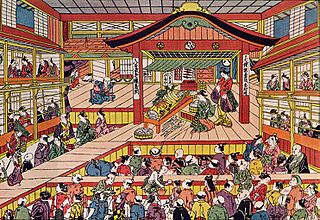
Ukiyo-e is a genre of Japanese art that flourished from the 17th through 19th centuries. Its artists produced woodblock prints and paintings of such subjects as female beauties; kabuki actors and sumo wrestlers; scenes from history and folk tales; travel scenes and landscapes; flora and fauna; and erotica. The term ukiyo-e translates as 'picture[s] of the floating world'.

Katsushika Hokusai, known simply as Hokusai, was a Japanese ukiyo-e artist of the Edo period, active as a painter and printmaker. He is best known for the woodblock print series Thirty-Six Views of Mount Fuji, which includes the iconic print The Great Wave off Kanagawa. Hokusai was instrumental in developing ukiyo-e from a style of portraiture largely focused on courtesans and actors into a much broader style of art that focused on landscapes, plants, and animals. His works are thought to have had a significant influence on Vincent van Gogh and Claude Monet during the wave of Japonisme that spread across Europe in the late 19th century.

Japanese art covers a wide range of art styles and media, including ancient pottery, sculpture, ink painting and calligraphy on silk and paper, ukiyo-e paintings and woodblock prints, ceramics, origami, and more recently manga and anime. It has a long history, ranging from the beginnings of human habitation in Japan, sometime in the 10th millennium BCE, to the present day.

Utagawa Kunisada, also known as Utagawa Toyokuni III, was a Japanese ukiyo-e artist. He is considered the most popular, prolific and commercially successful designer of ukiyo-e woodblock prints in 19th-century Japan. In his own time, his reputation far exceeded that of his contemporaries, Hokusai, Hiroshige and Kuniyoshi.

Leiden University Libraries is a library founded in 1575 in Leiden, Netherlands. It is regarded as a significant place in the development of European culture: it is a part of a small number of cultural centres that gave direction to the development and spread of knowledge during the Enlightenment. This was due particularly to the simultaneous presence of a unique collection of exceptional sources and scholars. Holdings include approximately 5,200,000 volumes, 1,000,000 e-books, 70,000 e-journals, 2,000 current paper journals, 60,000 Oriental and Western manuscripts, 500,000 letters, 100,000 maps, 100,000 prints, 12,000 drawings and 300,000 photographs. The library manages the largest collections worldwide on Indonesia and the Caribbean. Furthermore, Leiden University Libraries is the only heritage organization in The Netherlands with five registrations of documents in UNESCO's Memory of the World Register.

Japonisme is a French term that refers to the popularity and influence of Japanese art and design among a number of Western European artists in the nineteenth century following the forced reopening of foreign trade with Japan in 1858. Japonisme was first described by French art critic and collector Philippe Burty in 1872.
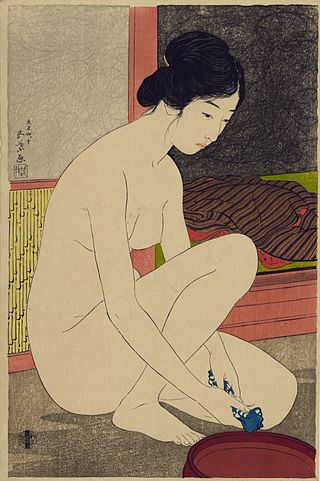
Shin-hanga was an art movement in early 20th-century Japan, during the Taishō and Shōwa periods, that revitalized the traditional ukiyo-e art rooted in the Edo and Meiji periods. It maintained the traditional ukiyo-e collaborative system where the artist, carver, printer, and publisher engaged in division of labor, as opposed to the parallel sōsaku-hanga movement.

Sōsaku-hanga was an art movement of woodblock printing which was conceived in early 20th-century Japan. It stressed the artist as the sole creator motivated by a desire for self-expression, and advocated principles of art that is "self-drawn", "self-carved" and "self-printed". As opposed to the parallel shin-hanga movement that maintained the traditional ukiyo-e collaborative system where the artist, carver, printer, and publisher engaged in division of labor.
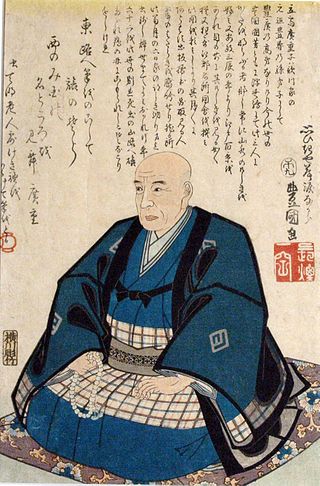
Utagawa Hiroshige, born Andō Tokutarō, was a Japanese ukiyo-e artist, considered the last great master of that tradition.

Toyohara Kunichika was a Japanese woodblock print artist. Talented as a child, at about thirteen he became a student of Tokyo's then-leading print maker, Utagawa Kunisada. His deep appreciation and knowledge of kabuki drama led to his production primarily of yakusha-e, which are woodblock prints of kabuki actors and scenes from popular plays of the time.

Isoda Koryūsai was a Japanese ukiyo-e print designer and painter active from 1769 to 1790.

Hiroshi Yoshida was a 20th-century Japanese painter and woodblock printmaker. He is regarded as one of the greatest artists of the shin-hanga style, and is noted especially for his landscape prints. Yoshida travelled widely, and was particularly known for his images of non-Japanese subjects done in traditional Japanese woodblock style, including the Taj Mahal, the Swiss Alps, the Grand Canyon, and other National Parks in the United States.
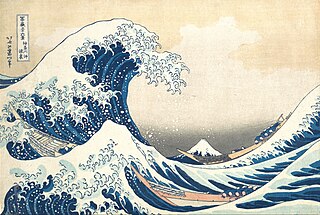
Woodblock printing in Japan is a technique best known for its use in the ukiyo-e artistic genre of single sheets, but it was also used for printing books in the same period. Widely adopted in Japan during the Edo period (1603–1868) and similar to woodcut in Western printmaking in some regards, the mokuhanga technique differs in that it uses water-based inks—as opposed to western woodcut, which typically uses oil-based inks. The Japanese water-based inks provide a wide range of vivid colors, glazes, and transparency.

Isaac Titsingh FRS was a Dutch diplomat, historian, Japanologist, and merchant. During a long career in East Asia, Titsingh was a senior official of the Dutch East India Company. He represented the European trading company in exclusive official contact with Tokugawa Japan, traveling to Edo twice for audiences with the shogun and other high bakufu officials. He was the Dutch and VOC governor general in Chinsura, Bengal.
The Japanese Art Society of America (JASA) promotes the study and appreciation of Japanese art. Founded in 1973 as the Ukiyo-e Society of America by collectors of Japanese prints, the Society's mission has expanded to include related fields of Japanese art.
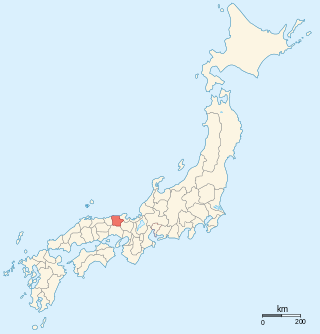
Utagawa Toyoharu was a Japanese artist in the ukiyo-e genre, known as the founder of the Utagawa school and for his uki-e pictures that incorporated Western-style geometrical perspective to create a sense of depth.
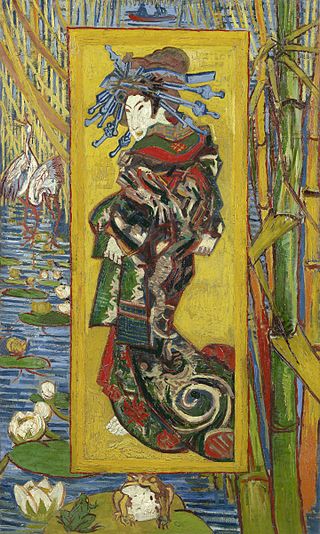
Japonaiserie was the term used by Dutch post-impressionist painter Vincent van Gogh to express the influence of Japanese art on his works.
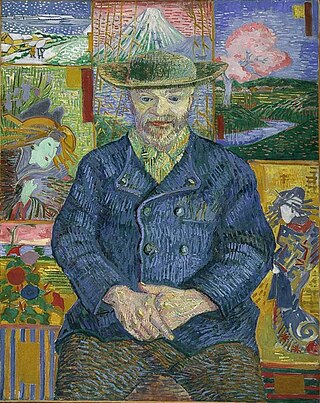
Portrait of Père Tanguy, painted by Vincent van Gogh in 1887, is one of his three paintings of Julien Tanguy. The three works demonstrate a progression in van Gogh's artistic style after his arrival in Paris. The first is somber, and formed from a simple composition. The second introduces van Gogh's Japanese prints. The last and most advanced in style, skill and color integrates Japanese, Impressionist, and other influences on the Parisian artist community. This painting conveys a sense of serenity that van Gogh seeks for himself. This last painting of Tanguy is in the Musée Rodin, Paris.
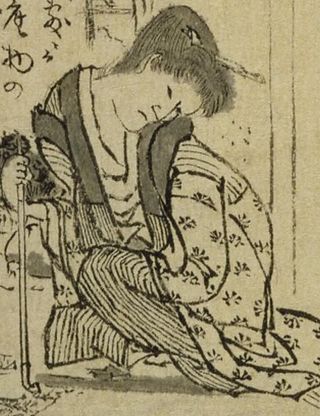
Katsushika Ōi, also known as Ei (栄) or Ei-jo, was a Japanese Ukiyo-e artist of the early 19th century Edo period. She was a daughter of Hokusai from his second wife. Ōi was an accomplished painter who also worked as a production assistant to her father.
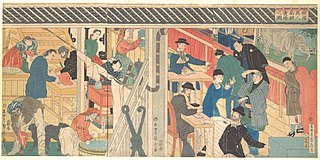
Utagawa Sadahide, also known as Gountei Sadahide, was a Japanese artist best known for his prints in the ukiyo-e style as a member of the Utagawa school. His prints covered a wide variety of genres; amongst his best known are his Yokohama-e pictures of foreigners in Yokohama in the 1860s, a period when he was a best-selling artist. He was a member of the Tokugawa shogunate's delegation to the International Exposition of 1867 in Paris.
References
- ↑ Art Listings
- ↑ Artlino.com
- 1 2 "About us | Society for Japanese Art". www.societyforjapaneseart.org. Retrieved 2021-06-16.
- ↑ viewing Japanese Prints